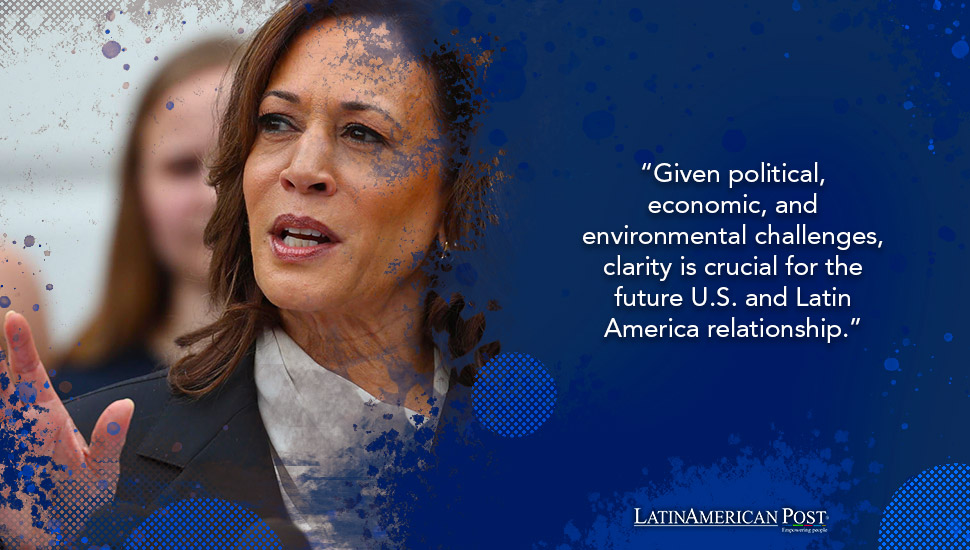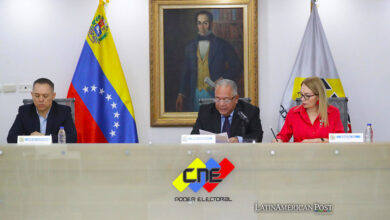Kamala Harris’ Ambiguous Stance on Latin America Amid Ongoing Crises

As Kamala Harris’ bid for the U.S. presidency continues, her vague stance on Latin American policies raises concerns for a region already grappling with crises. Given political, economic, and environmental challenges, clarity is crucial for the future U.S. and Latin America relationship.
With the 2024 U.S. presidential elections approaching, political analysts are trying to determine what a potential Kamala Harris presidency would mean for Latin America. The lack of a clear stance on significant regional issues leaves many Latin American nations uncertain about how U.S. foreign policy might shift. This ambiguity is particularly alarming, considering the region faces multiple crises, including rising authoritarianism, economic instability, and environmental challenges.
Harris has not defined a specific vision for Latin America so far. While she has been involved in some diplomatic initiatives, such as addressing migration and poverty in Central America, her broader Latin American policy remains largely undeclared. This is a significant gap, especially given the region’s importance to U.S. interests in terms of trade, immigration, and regional stability. As Latin America grapples with growing discontent, economic challenges, and environmental degradation, Harris’ hesitancy to outline clear policies presents a missed opportunity for engagement.
Environmental and Economic Dilemmas
Latin America faces a complex intersection of issues: the need for economic growth, the protection of indigenous communities, and the fight against environmental degradation. While Harris has shown support for environmental and labor concerns in the past, these are delicate topics in Latin America, where extractive industries are often pitted against environmental preservation and indigenous rights.
For example, many Latin American countries rely heavily on natural resource extraction. Mining, logging, and oil exploration are central to their economies, even as these activities take a heavy toll on the environment. Harris’ progressive stance on environmental issues, as seen in her opposition to trade agreements like the Trans-Pacific Partnership (TPP) on ecological grounds, could put her at odds with Latin American governments seeking economic development through resource extraction.
At the same time, the region’s Indigenous populations, such as the Mashco Piro in Peru, are increasingly at odds with industries encroaching on their lands. Protecting these communities while supporting Latin America’s economic growth would require careful balancing. Harris’s lack of engagement with these critical issues raises concerns about whether she understands the region’s unique struggles.
Similar conflicts have arisen when economic needs clash with environmental protection and indigenous rights. In Brazil, the construction of hydroelectric dams in the Amazon during the 1980s led to protests from indigenous groups whose lands were threatened. It wasn’t until the intervention of international environmental organizations and negotiations with the Brazilian government that some of the more destructive projects were modified or halted. Such historical precedents show robust and informed leadership is needed to mediate these clashes. Whether Harris could provide this leadership remains in question.
Missed Opportunities for Economic Integration and Trade
Economic relations between the U.S. and Latin America have long been a cornerstone of foreign policy in the hemisphere. However, Harris’ voting record in the Senate suggests a more protectionist and cautious approach to trade, especially when environmental or labor rights are at stake. She voted against the renegotiated North American Free Trade Agreement (NAFTA) and the United States-Mexico-Canada Agreement (USMCA), citing environmental and labor concerns.
While this approach may align with progressive values, it risks alienating critical Latin American trading partners. Trade agreements like NAFTA have played a vital role in fostering economic ties between the U.S. and Latin America, providing markets for goods and services and promoting financial stability in the region. Harris risks signaling that economic integration with Latin America is not a priority by opposing these agreements.
Latin America, already struggling with inflation, debt, and slowing growth, needs stable economic partnerships. Countries like Mexico and Brazil are significant trading partners for the U.S., and any perceived withdrawal from these relationships could further destabilize economies heavily reliant on U.S. exports and imports. Harris’s lack of emphasis on these crucial economic ties leaves many wondering if she fully grasps the importance of Latin American markets for both the region and the U.S.
In contrast, historical figures like Franklin D. Roosevelt implemented the “Good Neighbor” policy, prioritizing diplomatic and economic engagement with Latin America during global economic uncertainty. By strengthening economic ties, Roosevelt stabilized the region and fostered goodwill toward the U.S. Harris’ reluctance to clarify her stance on trade with Latin America represents a missed opportunity to renew and strengthen these crucial relationships.
Immigration: Pragmatism or Political Calculus?
One of the most pressing issues in U.S.-Latin America relations is immigration, particularly from Central America. Under the Biden administration, Harris was tasked with addressing the “root causes” of migration, including poverty, violence, and political instability in countries like Guatemala, Honduras, and El Salvador. However, her results in this area have been mixed. Critics argue that she has not delivered meaningful progress in reducing the flow of migrants from these countries, and her hardline stance on border security has raised eyebrows among both progressive and conservative analysts.
Harris’ shifting rhetoric on immigration—supporting more rigid border controls while also focusing on addressing root causes—reflects the broader political divide in the U.S. on this issue. Latin American countries, especially those in Central America, watch this debate closely, as U.S. immigration policy has a direct impact on their populations. Migrants fleeing violence and poverty in their home countries often see the U.S. as their last hope. Without a clear, consistent policy on how to manage both immigration and foreign aid, Harris risks alienating both U.S. voters and Latin American leaders.
Historically, U.S. immigration policy has swung between welcoming immigrants during times of economic expansion and restricting their entry during periods of nativist backlash. Harris’ emphasis on enforcing U.S. laws and securing the border, while understandable from a political standpoint, may signal a retreat from previous efforts to provide humanitarian aid and support to countries facing crises. This shift could devastate Latin America, especially as the region faces ongoing political instability.
Building Alliances or Burning Bridges?
One of Harris’ strengths is her recognition that the U.S. cannot address global challenges alone. Her experience forming international coalitions, such as those supporting Ukraine after Russia’s 2022 invasion, will likely inform her broader foreign policy approach. However, her limited engagement with Latin America—both in terms of travel and policy initiatives—raises concerns about whether she would prioritize the region as former Vice President Joe Biden did during his tenure.
Latin America faces numerous crises that demand U.S. attention, from the humanitarian disaster in Haiti to the growing authoritarianism in countries like Venezuela and Nicaragua. Harris’ previous lack of focus on these issues, combined with her more generalized approach to foreign policy, could indicate that Latin America would take a backseat in her administration.
The Biden administration’s decision to engage with Latin America on climate change and migration has been essential to repairing relations. However, Harris’ failure to outline a coherent vision for the region leaves a gap that could be exploited by authoritarian regimes and other actors looking to destabilize Latin America. Suppose the U.S. doesn’t maintain strong alliances in the region. In that case, it risks losing influence to countries like China, which has steadily increased its presence through trade and investment in Latin America.
Also read: The Early Release of Drug Lords Imprisoned in the U.S. and the Latin American Confusion
Historically, U.S. foreign policy toward Latin America has often been characterized by neglect and interventionism. The Cold War-era interventions in Cuba, Chile, and Nicaragua are examples of how the U.S. has, at times, taken an aggressive approach to the region, prioritizing its interests over those of Latin American nations. In today’s world, a more nuanced, cooperative approach is needed to acknowledge the region’s sovereignty while fostering partnerships based on mutual respect and shared goals.





